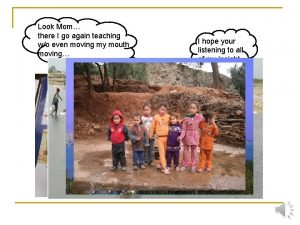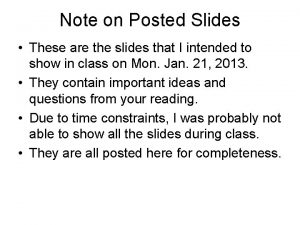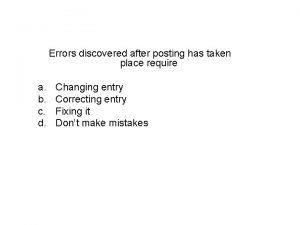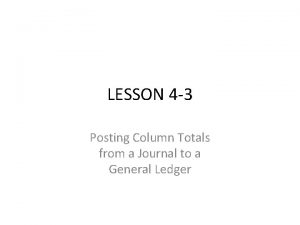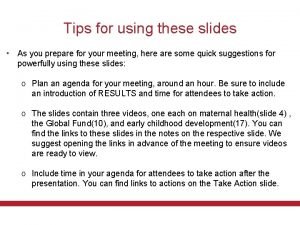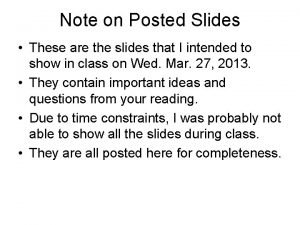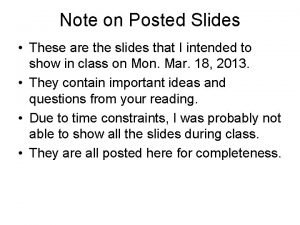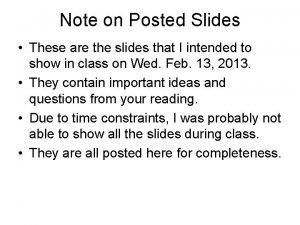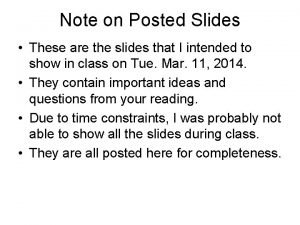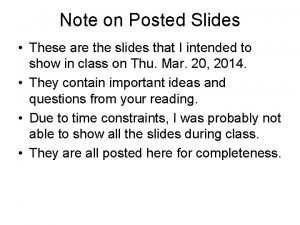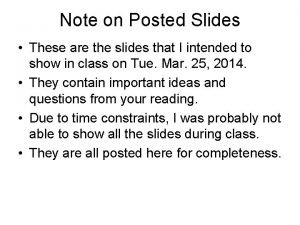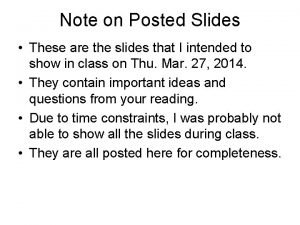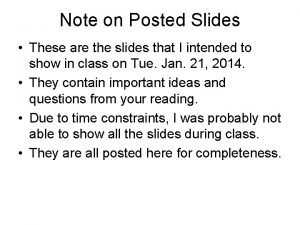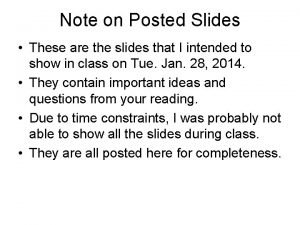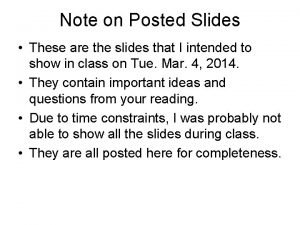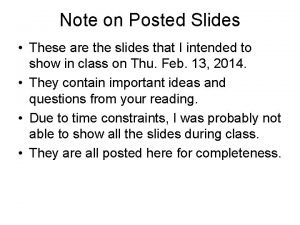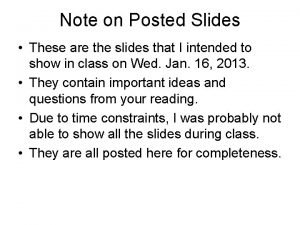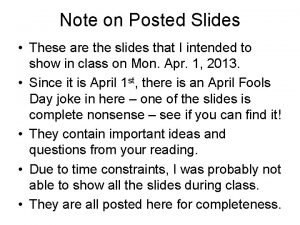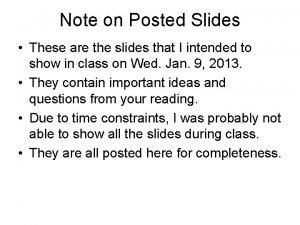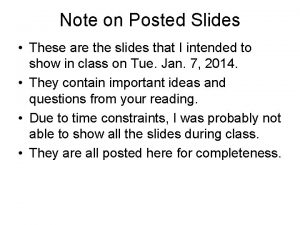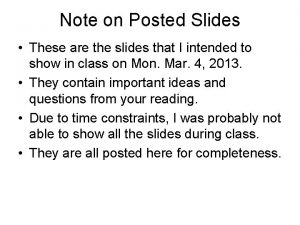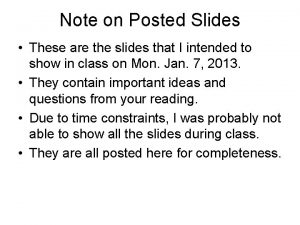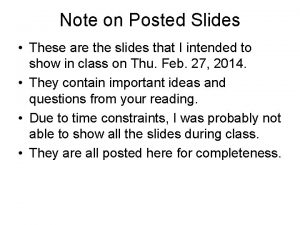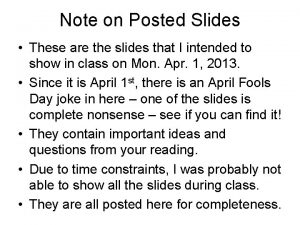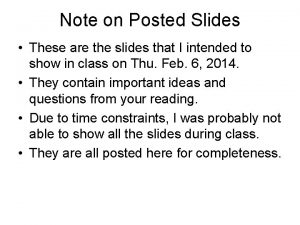Note on Posted Slides These are the slides






































- Slides: 38

Note on Posted Slides • These are the slides that I intended to show in class on Thu. Jan. 23, 2014. • They contain important ideas and questions from your reading. • Due to time constraints, I was probably not able to show all the slides during class. • They are all posted here for completeness.

PHY 205 H 1 S Physics of Everyday Life Class 6: Energy • • Energy Power Potential and Kinetic Conservation of Energy Efficiency Recycled Energy for Life Sources of Energy [image from http: //www. nytimes. com/imagepages/2006/11/28/business/28 plug. ready. html]

Work • involves force and distance. • is force distance. • in equation form: W Fd. Two things occur whenever work is done: • application of force • movement of something by that force Unit of work: newton-meter (N·m) or joule (J)

Work can be positive, zero or negative • When the force and the distance are in the same direction, you are helping the motion with the force, so the work done on the object is positive. • The force is adding energy to the object + environment. • Maybe this force is speeding the object up. F d

Work can be positive, zero or negative • When the force and the distance are at right angles, you are not helping the motion with the force, so the work is zero. • This force is not changing the energy of the object. • This force won’t speed the object up or slow it down. F d

Work can be positive, zero or negative • When the force and distance are in opposite directions, you are hindering the motion with the force, so the work done on the object is negative. • This force is reducing the energy of the object. • Maybe this force is slowing the object down. F d

Discussion Question • Justin is doing a bench press, and he slowly pushes the bar up a distance of 0. 30 m while pushing upwards on the bar with a force of 200 N. The bar moves with a constant velocity during this time. • During the upward push, how much work does Justin do on the bar? A. 60 J B. 120 J C. 0 J D. -60 J E. -120 J

Discussion Question • Justin is doing a bench press, and he slowly lowers the bar down a distance of 0. 30 m while pushing upwards on the bar with a force of 200 N. The bar moves with a constant velocity during this time. • During the downward lowering, how much work does Justin do on the bar? A. 60 J B. 120 J C. 0 J D. -60 J E. -120 J

Discussion Question • Justin is doing a bench press, and he slowly lowers the bar down a distance of 0. 30 m while pushing upwards on the bar with a force of 200 N. He then pushes it up slowly the same distance of 0. 30 m back to its starting position, also pushing upwards on the bar with a force of 200 N. • During the complete downward and upward motion, how much total work does Justin do on the bar? A. 60 J B. 120 J C. 0 J D. -60 J E. -120 J

Power • Measure of how fast work is done • In equation form: Unit of power • joule per second, called the watt after James Watt, developer of the steam engine • 1 joule/second 1 watt • 1 kilowatt 1000 watts

Power • The unit of power is the watt, which is defined as 1 watt = 1 W = 1 J/s • Energy is measured by Ontario Hydro in k. Wh “kilo. Watt hours”. • 1 k. Wh is the amount of energy used by a power of 1 k. W over 1 hour • 1 k. Wh = 1000 J/s * 60 min/hour * 60 s/min • 1 k. Wh = 3. 6 million Joules [Chart downloaded Jan. 23 2013 from http: //www. ontario-hydro. com/index. php? page=current_rates ]

Example • Your clothes dryer uses 5000 Watts and you need to run it for 1 hour to dry your clothes. • If you run it during “on peak” time, such as between 7 and 11 am on a weekday, the cost is 12 cents/k. Wh. • If you run it during “off peak” on the weekend the price for Ontario Hydro electricity is 6 cents/k. Wh. • How much money do you save per load by doing your laundry on the weekend? [image downloaded Jan. 23 2013 from http: //www. sierraclubgreenhome. com/go-green/appliances/washers-and-dryers / ]

Elastic Potential Energy Stored energy held in readiness with a potential for doing work Examples: • A stretched bow has stored energy that can do work on an arrow. • A stretched rubber band of a slingshot has stored energy and is capable of doing work. • Demonstration: A mousetrap that is “set” has elastic potential energy that is capable of killing the mouse!

Gravitational Potential Energy Potential energy due to elevated position Example: • coffee mug on the top shelf • In equation form: Potential energy mass acceleration due to gravity height

Demonstration A rectangular solid such as a domino has more gravitational potential energy when it is tipped up on its edge, because its centre of mass is higher The energy is added to the domino by the work you do in tipping it up on its edge. [image retrieved Jan. 23 2013 from http: //www. decodedscience. com/a-quick-explanation-of-mathematical-induction/1420 ] Gravitational Potential Energy

Kinetic Energy • Energy of motion • Depends on the mass of the object and square of its speed: If object speed is doubled kinetic energy is quadrupled.

What is “energy”? • Energy is a property of an object, like age or height or mass. • Every object that is moving has some Kinetic Energy. • Objects in a gravitational or electric field may also have Potential Energy. • Energy has units, and can be measured. • Energy is relative; kinetic energy of car is different for an observer in the car than it is for an observer standing on the side of the road.

Work and Kinetic Energy • If an object starts from rest and there is a net force doing work on it, the work done will be equal to the final kinetic energy of the object. • In equation form:

Work-Energy Theorem Work-energy theorem • Gain or reduction of energy is the result of work. • In equation form: work change in kinetic energy (W K). • Doubling speed of an object requires 4 times the work.

Work-Energy Theorem • Applies to decreasing speed: – reducing the speed of an object or bringing it to a halt Example: Applying the brakes to slow a moving car, work is done on it (the friction force supplied by the brakes distance).

Work-Energy Theorem CHECK YOUR NEIGHBOR The work done in bringing a moving car to a stop is the force of tire friction stopping distance. If the initial speed of the car is doubled, the stopping distance is A. B. C. D. actually less. about the same. twice. None of the above.

Chapter 7 big idea: “Conservation of Energy” • A system of particles has a total energy, E. • If the system is isolated, meaning that there is no work or heat being added or removed from the system, then: Ef = Ei • This means the energy is “conserved”; it doesn’t change over time. • This is also the first law of thermodynamics; “You can’t get something for nothing. ”


EXAMPLE 1: The speed of a sled • Claire runs forward with her sled at 2 m/s. • She hops at the top of a very slippery slope. • The slope is 7° below the horizontal, and extends down a total vertical distance of 5 m. • What is her speed at the bottom? [neglect friction] © 2010 Pearson Education, Inc.

EXAMPLE 2: The speed of a sled • Claire runs forward with her sled at 2 m/s. • She hops at the top of a very slippery valley. • The valley goes down to 5 m below her starting position, then back up to the same initial height. • What is her speed when she reaches the other side of the valley? [neglect friction] © 2010 Pearson Education, Inc.

Discussion Question on Conservation of Energy • An object is flying through the air with nothing touching it. • Neglect air resistance. • Is energy of the object conserved? A. Yes B. No

Discussion Question • A 1 kg object is dropped from rest a height of 3 m above the ground. • Just before it hits the ground, what is its kinetic energy? [Neglect air resistance. ] A. 3 J B. 15 J C. 30 J D. 90 J E. 150 J

A situation to ponder… CHECK YOUR NEIGHBOR Suppose the potential energy of a drawn bow is 50 joules and the kinetic energy of the shot arrow is 40 joules. Then A. B. C. D. energy is not conserved. 10 joules go to warming the bow. 10 joules go to warming the target. 10 joules are mysteriously missing.

Machines • Devices for multiplying forces or changing the direction of forces • Cannot create energy but can transform energy from one form to another, or transfer energy from one location to another • Cannot multiply work or energy

Machines Principles of a machine: • Conservation of energy concept: Work input work output • Input force input distance Output force output distance • (Force distance)input (force distance)output

Simplest machine: • Lever – rotates on a point of support called the fulcrum – allows small force over a large distance and large force over a short distance

Pulleys This arrangement operates like a lever with equal arms — changes the direction of the input force: This arrangement can allow a load to be lifted with half the input force:

Efficiency • Percentage of work put into a machine that is converted into useful work output • In equation form: useful energy output Efficiency total energy input

Recycled Energy • Re-employment of energy that otherwise would be wasted. • Edison used heat from his power plant in New York City to heat buildings. • Typical power plants waste about 30% of their energy to heat because they are built away from buildings and other places that use heat.

Sources of Energy Sun Examples: • Sunlight evaporates water; water falls as rain; rain flows into rivers and into generator turbines; then back to the sea to repeat the cycle. • Wind power turns generator turbines.

Sources of Energy Example: • Photovoltaic cells on rooftops catch the solar energy and convert it to electricity. More energy from the Sun hits Earth in 1 hour than all of the energy consumed by humans in an entire year!

Sources of Energy Concentrated energy • Nuclear power – stored in uranium and plutonium – doesn’t pollute our atmosphere – creates radioactive waste which, if stored near humans, can be toxic.

Before Class 7 on Tuesday • Please read Chapter 8, or at least watch the 10 -minute pre-class video for class 7 • Keep in mind: • Test in 1 week: Thursday during class time in EX 100, which is 255 Mc. Caul St. • Test will begin promptly at 10 minutes past the hour and will be 50 minutes long – if you can be there a bit early that would be great. • Please bring a calculator, and, if you wish, an 8. 5 x 11” aid sheet upon which you may write anything you wish on both sides • Test will cover Hewitt chapters 2 -8, and will include some multiple choice and some short-answer
 Insidan region jh
Insidan region jh Difference between note making and note taking
Difference between note making and note taking Note taking and note making
Note taking and note making Financial documents order
Financial documents order Simple discount example
Simple discount example Difference between note making and note taking
Difference between note making and note taking What is debit note
What is debit note Examples of signal words
Examples of signal words What is a debit note
What is a debit note Signage posted at a handwashing station must include
Signage posted at a handwashing station must include Look mom europe
Look mom europe Voucher rack in front office
Voucher rack in front office Examples of momentum
Examples of momentum Errors discovered after posting has taken place requires
Errors discovered after posting has taken place requires What is an infrared thermometer best used for servsafe
What is an infrared thermometer best used for servsafe Post the journal’s special amount column totals.
Post the journal’s special amount column totals. A small child slides down the four frictionless slides
A small child slides down the four frictionless slides A crane lowers a girder into place
A crane lowers a girder into place These slides
These slides Following slides
Following slides These slides
These slides Thế nào là hệ số cao nhất
Thế nào là hệ số cao nhất Trời xanh đây là của chúng ta thể thơ
Trời xanh đây là của chúng ta thể thơ Lp html
Lp html Số nguyên tố là gì
Số nguyên tố là gì đặc điểm cơ thể của người tối cổ
đặc điểm cơ thể của người tối cổ Vẽ hình chiếu vuông góc của vật thể sau
Vẽ hình chiếu vuông góc của vật thể sau Các châu lục và đại dương trên thế giới
Các châu lục và đại dương trên thế giới Tư thế worms-breton
Tư thế worms-breton Hệ hô hấp
Hệ hô hấp ưu thế lai là gì
ưu thế lai là gì Tư thế ngồi viết
Tư thế ngồi viết Cái miệng nó xinh thế chỉ nói điều hay thôi
Cái miệng nó xinh thế chỉ nói điều hay thôi Mật thư anh em như thể tay chân
Mật thư anh em như thể tay chân Bổ thể
Bổ thể Tư thế ngồi viết
Tư thế ngồi viết Thế nào là giọng cùng tên? *
Thế nào là giọng cùng tên? * Thẻ vin
Thẻ vin Thể thơ truyền thống
Thể thơ truyền thống










